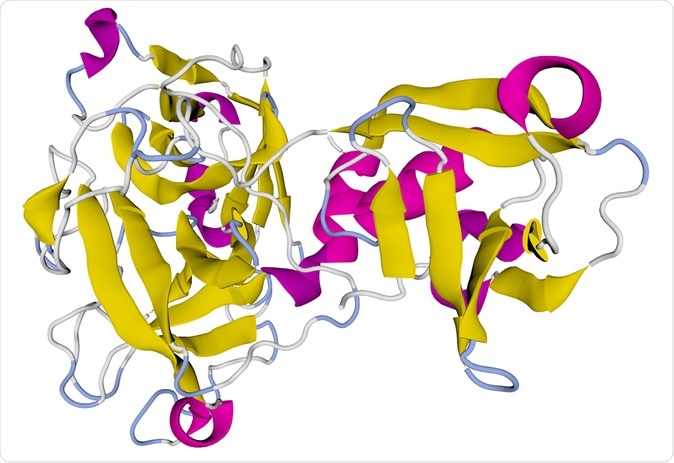Study shows children and adults have a comparable expression of SARS-CoV-2 entry-related genes
by Dr. Tomislav Meštrović, MD, Ph.D.A recent paper by researchers from China demonstrated comparable expression levels of severe acute respiratory syndrome coronavirus 2 (SARS-CoV-2) cell entry mediators in adults and children, suggesting that previously implied difference in viral-entry associated genes is likely not responsible for milder symptoms in children. The study is currently available on the medRxiv* preprint server.
Health clinicians, researchers, and scientists worldwide are collectively contributing to our understanding of coronavirus disease (COVID-19) pandemic, which is currently the biggest public health issue caused by SARS-CoV-2. Such a collaborative endeavor resulted in substantial insights into disease pathophysiology.
Consequently, we now understand that angiotensin-converting enzyme 2 (ACE2) acts as the key receptor for SARS-CoV-2 cell entry by interacting with the spike protein of the virus. The latter structure is then cleaved by transmembrane protease serine 2 (TMPRSS2), while FURIN protein represents an auxiliary mechanism for viral priming.

Study: SARS-CoV-2 entry related genes are comparably expressed in children's lung as adults. TMPRSS2 Human ball and stick model, entry receptor for SARS-CoV-2. Image Credit: OMMB / Shutterstock
COVID-19 in children
Albeit limited, the available data suggests that the SARS-CoV-2 infection is rare and less severe in children. Nonetheless, some recent studies pointed out that kids are just as likely to get infected with SARS-CoV-2 when they are found in a similar environment with adults.
The infection rate among all children younger than ten was 7.4%, comparable to the population average. Furthermore, current guidelines also state that all individuals – including children – are generally susceptible to SARS-CoV-2. In the meantime, children present with a low incidence of critical illness, although the underlying mechanism is yet to be elucidated.
In addition, the accumulating clinical data show better clinical outcomes of COVID-19 in children compared to adults. Two dominant theories try to explain this finding: potentially lower expression of viral-entry associated genes in children and various immune-related factors. However, both the expression and the activity of ACE2 during child development are by and large unclear.
Accordingly, the group of Chinese researchers aimed to appraise the expression levels of viral-entry associated genes (i.e., ACE2, TMPRSS2, and FURIN) in children and adults' lung tissues by using single-cell RNA sequencing (scRNA-seq) and immunohistochemistry. In short, they wanted to explore whether the gene expression levels might contribute to the milder symptoms in children.
Genome sequencing and immunohistochemistry
In this study, non-affected lung tissues from four children presenting with congenital heart disease and lung disease resulting in lobectomy were collected, while the transcriptome of 16,530 cells in total has been appraised by using single scRNA-seq technology.
Specific scRNA-Seq technology allows scientists to ask and answer questions that necessitate single-cell resolution on a scale that suits specific experimental needs, ranging from hundreds to millions of cells. It utilizes an optimized next-generation sequencing approach and provides a better understanding of how individual cells function in the context of their microenvironment.
In addition, immunohistochemistry (a microscopy-based technique for visualizing cellular components) was performed in the lung biopsy specimens from children and adults. The combination of these two methods allows an impartial interpretation of the results since semi-quantitative characteristics of immunohistochemistry has certain limitations in identifying cell types.
A comparable levels of entry mediators
This study was a pioneering attempt to describe the features of children's lungs by using scRNA-seq analysis and immunohistochemistry. In general, there were no significant changes in the expression levels of ACE2, TMPRSS2, and FURIN between adults and children, even though the percentage of cells expressing TMPRSS2 and FURIN were found to be higher in adults.
Moreover, when compared to a public dataset of eight adult lung donors, the cell subtypes in children were basically the same as those in adults, even though fewer cells were obtained from children's lung tissues.
Similarly, scRNA-seq showed that AT2, AT1, and club cells were the major cell types both in children and adults, with relatively high expression of TMPRSS2. The expression pattern of FURIN slightly differed; in children, it was more pronounced in AT2 and club cells, while in adults, it predominantly occurred in monocytes and enterochromaffin cells.
The overall expression levels of ACE2 was comparable in children and adults, even when immunohistochemistry was used. However, there was a small discrepancy in comparison to scRNA-seq analysis, as both TMPRSS2 and FURIN showed higher expression in children. This is why only a combination of these two methods can provide an impartial interpretation of the results.
Milder infections in children remain unexplained
Instead of lower virus intrusion rate, other factors (most notably distinctive characteristics pertinent to children's immune system) may play a more important role. A pronounced immune profile during infections is observed due to the underdevelopment of the immune system. At the same time, frequent exposure of children to a myriad of other pathogens repeatedly challenges the innate immunity.
*Important Notice
medRxiv publishes preliminary scientific reports that are not peer-reviewed and, therefore, should not be regarded as conclusive, guide clinical practice/health-related behavior, or treated as established information.
Journal reference:
- Tao, Y. et al. (2020). SARS-CoV-2 entry related genes are comparably expressed in children's lung as adults. medRxiv. https://doi.org/10.1101/2020.05.25.20110890.